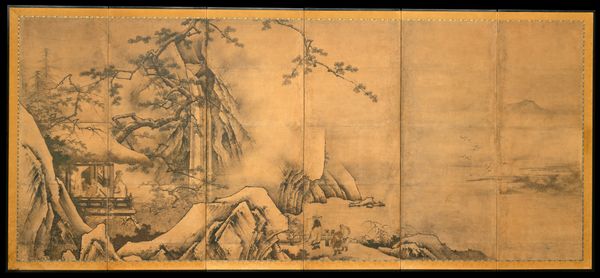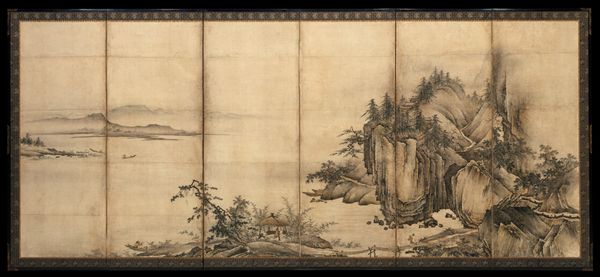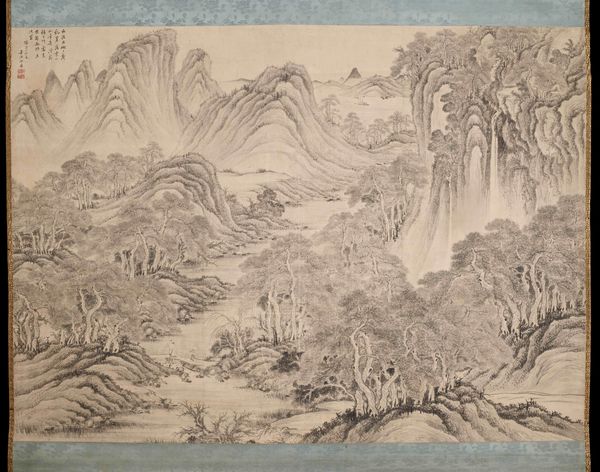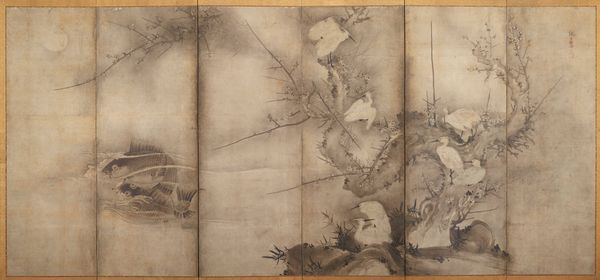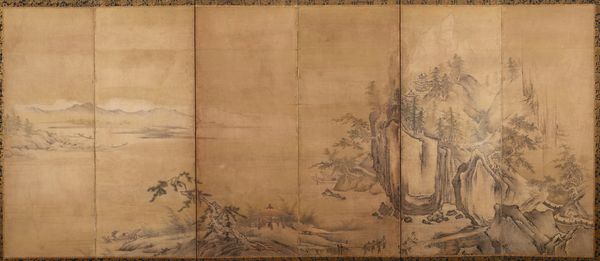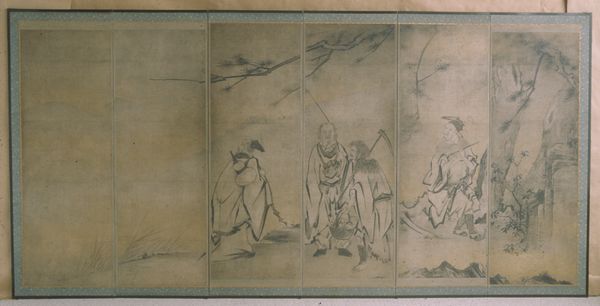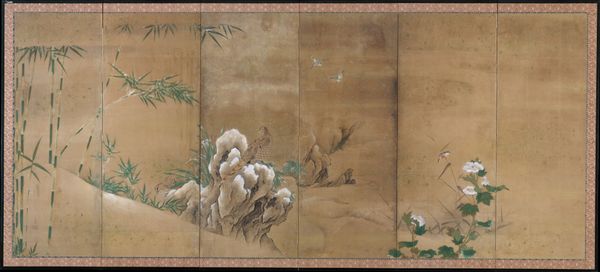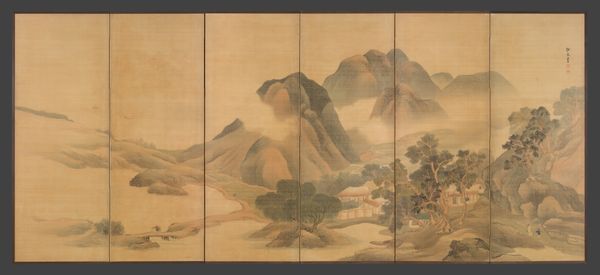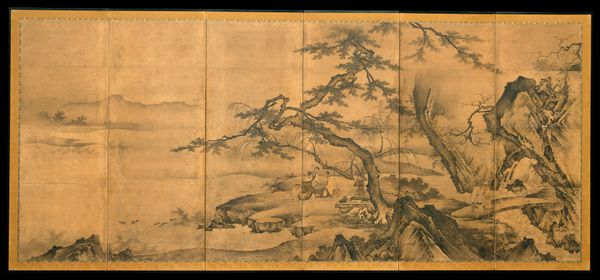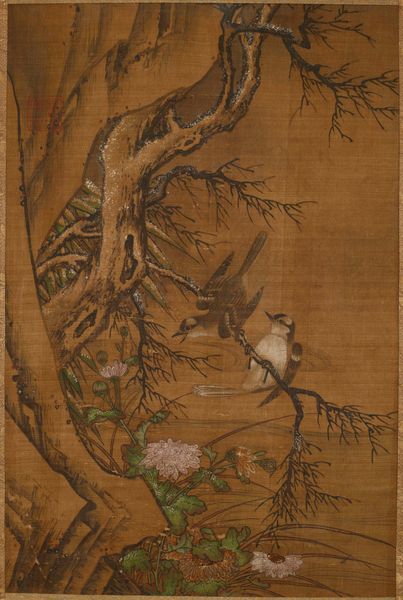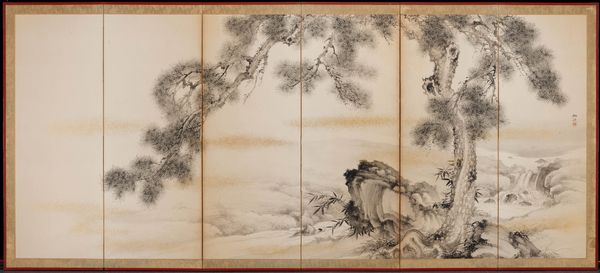![Birds in Landscape [right of a pair] by Shūgetsu Tōkan](/_next/image?url=https%3A%2F%2Fd2w8kbdekdi1gv.cloudfront.net%2FeyJidWNrZXQiOiAiYXJ0ZXJhLWltYWdlcy1idWNrZXQiLCAia2V5IjogImFydHdvcmtzLzg0NDdmNjdiLWIxZmMtNDBkMC05YTNhLTA1YzU4MzYxODc4MC84NDQ3ZjY3Yi1iMWZjLTQwZDAtOWEzYS0wNWM1ODM2MTg3ODBfZnVsbC5qcGciLCAiZWRpdHMiOiB7InJlc2l6ZSI6IHsid2lkdGgiOiAxOTIwLCAiaGVpZ2h0IjogMTkyMCwgImZpdCI6ICJpbnNpZGUifX19&w=3840&q=75)
Birds in Landscape [right of a pair] c. early 16th century
0:00
0:00
Dimensions: 60 1/2 × 141 1/8 in. (153.67 × 358.46 cm) (image)66 × 146 5/8 × 3/4 in. (167.64 × 372.43 × 1.91 cm) (mount)
Copyright: Public Domain
Curator: Welcome. We’re standing before a serene ink and watercolor landscape, part of a pair entitled “Birds in Landscape,” believed to be created by Shūgetsu Tōkan around the early 16th century. It currently resides here at the Minneapolis Institute of Art. Editor: Well, my first impression is of stillness, despite all the life it depicts. It's muted, like a charcoal drawing faded by time. What strikes me is the way the artist balances these delicate, almost melancholic tones. Curator: Precisely. These folding screens served various purposes, from partitioning space to acting as backdrops for ceremonies. What's significant about Tōkan’s work is its synthesis of Chinese landscape painting traditions with uniquely Japanese sensibilities. Consider the emphasis on asymmetry, characteristic of Japanese aesthetics. Editor: Yes, and it’s not just decorative, is it? It invites you to consider a larger narrative – birds taking flight, the weight of those heavy trees…It's the kind of landscape that seems to breathe. I wonder what that solitary monkey is pondering, perched up there? Curator: Ah, indeed! Animals often feature as symbolic elements, carrying moral or philosophical weight. The cranes, for example, symbolize longevity and good fortune in East Asian art. In this cultural and political moment, screens such as these reflected the rise of warrior clans and a turn toward Zen Buddhism, which also favored monochrome landscape painting. Editor: Fascinating! It also feels really contemporary in its style. The simplification of the forms – they’re so reduced that the essence of nature almost comes forth. Curator: True. Also note the economical brushwork. With only a few strokes, Tōkan suggests form, texture, and even atmosphere. This approach reflects a certain Zen ideal of spontaneity and intuition. Editor: So, a piece born of both tradition and individual expression. I get a sense that while looking at this piece we are witnessing both an appreciation for craft, but a sense of human empathy to these beings’ story within the grand sweep of time. Curator: Ultimately, these “Birds in Landscape” speak to enduring themes: the interconnectedness of life, the harmony of nature, and the human desire to find our place within it all. It offers, perhaps, a quiet space for contemplation and, to use your word, empathy.
Comments
minneapolisinstituteofart almost 2 years ago
⋮
This pair of screens show a variety of birds among trees and flowers, a popular painting subject in the 1500s. At right, a horned owl in the far upper corner watches a boisterous scene below from his perch in the branches of a pine tree: a pair of hawks have zeroed in on a pair of white herons who run for cover toward lotuses and reeds. The left screen also features pairs of birds, including geese, cranes, and crested mynas among bamboo and a plum tree. Although the screens are not signed by the artist, the later painter Kano Yasunobu (1614–1685) wrote inscriptions on the outside edge of each screen assigning them to Shūgetsu Tōkan, a Zen priest and painter active 100 years earlier.
Join the conversation
Join millions of artists and users on Artera today and experience the ultimate creative platform.

